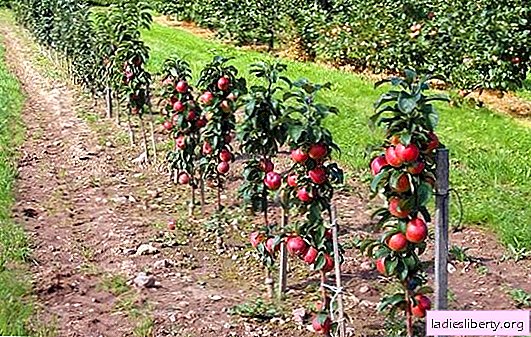
Blueberries belong to the family of heather crops. For the first time, this berry was grown in gardens in the XII century. It is difficult to determine the homeland of this culture: the first mention of blueberry dishes is found in the annals of Kievan Rus, the berries were also picked in the swamps of England and Scotland.
Garden blueberry is a cultivated subspecies of a wild plant. Bushes of garden blueberries give a greater yield than wild culture, its berries are sweeter and larger. However, their taste depends on the variety of blueberries.
There are over 75 varieties of this berry shrub. Some plants are frost-resistant and stunted, they tie a small number of berries, while others are tall and high-yielding. Planting conditions for garden blueberries for different varieties do not differ from each other.
Rules for planting garden blueberries
Blueberry is a marsh plant, so it loves acidic and moist soil. Like all plants from the heather family, garden blueberries are poorly rooted in a new place. If you provide good conditions for the growth of this crop, then you will get the first berry harvest three years after planting blueberries in open ground.
In order for the blueberry to take root well, you need to choose the right soil composition for it. The soil must be acidic or slightly acidic, with a pH level of 4 to 6.
For the further growth of blueberries, a large area is needed, therefore, under each bush they dig a landing pit 40 cm deep and 80 cm wide. It is filled with garden vermiculite or perlite by one third to ensure water drainage. Despite the fact that blueberries love frequent watering, when the water stagnates, its roots rot.
Soil composition for planting blueberries in open ground
Blueberries grow under natural conditions precisely in high peat, so the planting pit can be filled only with peat, but it is better to prepare the soil mixture. The soil for planting garden blueberries should consist of:
• from high peat;
• decayed spruce spruce branches;
• soil from under coniferous trees.
The amount of peat in the soil mixture should be at least 150 liters, given the volume of the planting pit. The percentage of peat in the soil mixture is 50%.

Planting scheme blueberries garden
Coniferous sawdust provides the soil mixture with phosphorus and potassium - trace elements necessary for better rooting of the seedling. If you fill the planting hole with peat only, then after planting garden blueberries, spill the soil with a rooting stimulator. You can use the branded drug "Radifarm".
This is a rooting stimulator based on the cells of simple algae, which enter into symbiosis with the roots of plants, absorb nutrients from the soil and give them to the root system.
Coniferous forest soil is added to the soil mixture to loosen it, as well as to simplify further garden blueberry care work:
• soil aeration;
• watering;
• fertilizing the soil.
The soil from the coniferous forest will provide air access to the roots of garden blueberries and, therefore, accelerate the rooting of its seedlings.
Due to frequent watering, the acidity of the soil decreases over time, so the so-called “Acidifying Preparations” of the long-acting soil are added to the planting pit before planting garden blueberries.
When preparing a place for planting garden blueberries, sulfur-based preparations are used. Usually, such products are yellow powder, but there are also colorless fertilizers. Such a powder does not need to be dissolved in water. The drug is simply embedded in the soil to a depth of 15 - 20 cm.
The amount of acidifier is calculated according to its instructions for use. When irrigated, sulfur will dissolve in water and increase the acidity of the soil.
The application of such fertilizers under the bush of blueberries is carried out twice a year: in the spring, after the threat of spring frosts has passed, and in September, before preparing the plant for wintering.
The filled planting pit is well shed with warm water to warm the soil to a temperature of + 18 ° C. Instead of ordinary water, you can use a solution of the growth stimulator of the root system to quickly root the seedling.
How to plant garden blueberries in open ground
Like all heather crops, garden blueberries do not tolerate transplanting into open ground, so only seedlings with a closed root system are suitable for planting on the garden plot. Blueberry roots should occupy the entire volume of the pot.
It is better to transplant a seedling into a prepared pit by transshipment. A pot with a plant is placed inside the planting pit, the container is carefully tilted, and at the same time the plant is removed from the pot.
Four vertical grooves are made on the root system of a seedling around the perimeter of an earthen coma. This will start the process of defensive reaction of the plant and accelerate the growth of the root system. Then the garden blueberry seedling is transferred to the prepared soil mixture. The bush is covered with dry peat, deepening a seedling by 10 cm.
After planting, the soil is once again well shed with warm water. The volume of water for each plant is 5 liters. Potassium permanganate or a biological fungicide can be dissolved in water to disinfect the soil. The potassium permanganate solution should be a saturated purple color.
Garden blueberry planting time
Planting blueberries can be carried out twice a year: in mid-May, when the threat of spring frosts passes, and in early September, until autumn frosts come. Autumn planting is not acceptable for all berry crops, but the growth of the blueberry root system is very fast, especially if you add a root growth stimulator to the soil. Therefore, seedlings have time to take root before the onset of frost.

Planted Blueberry Bush
Blueberry care after planting
Blueberries can withstand temperatures up to -15 ° C, so in the near-stem circle of a young seedling several pegs are placed on which agrofibre is pulled to cover the plant for the winter.
To avoid stagnation of water, young bushes mulch, and watering is carried out once a week. As mulch, you can use mowed grass, small pebbles or coniferous spruce branches. In spring, rotted cow manure and magnesium-containing fertilizer are introduced into the soil.
How to get a blueberry crop
Blueberries need cross-pollination to form an ovary, so at least two bushes of this crop, preferably of different varieties, need to be planted on the site. The berries of blueberries ripen unevenly, so the harvest process is stretched over time.
Ovary formation begins in late May. During this period, blueberries are covered with a net from birds, and potassium and magnesium-containing fertilizers are introduced into the soil. Flowering of all varieties of blueberries occurs at about the same time, sometimes with a difference of five days.
Harvesting from one bush, usually lasts a month, the ripening time depends on the variety of garden blueberries. Planting plants of varieties of different ripening dates will allow harvesting berries from mid-July to late September.

Blueberry harvest
Varieties of blueberries in terms of ripening berries are:
• early ("Blue gold", "Northland");
• medium ("Bonus", "Duke");
• late ("Blue crop", "Berkeley").
The advantage of garden blueberries is that this culture is practically not susceptible to viral and fungal diseases, so one preventive treatment with a biological fungicide at the end of May is enough.
Blueberry bush retains fruiting intensity for 30 years, only then the crops fall.











